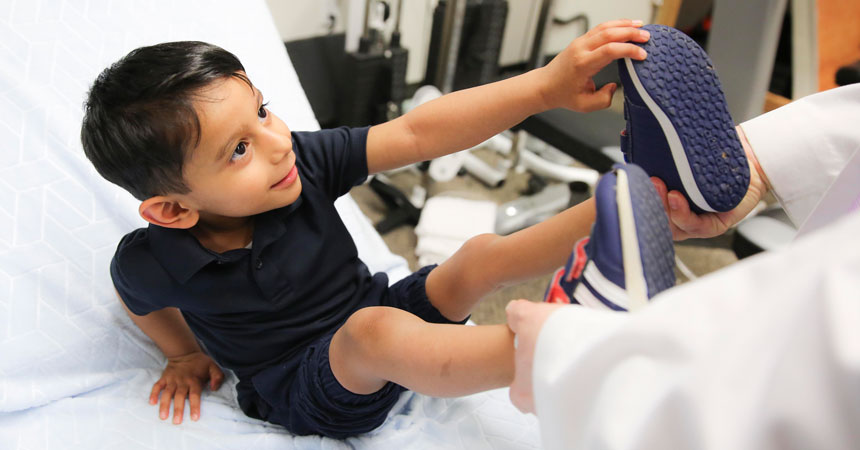Getting a child with a rare illness back on his feet
By Alex Branch
Zayd was about to start his first youth soccer program when his family’s nightmare with Acute Flaccid Myelitis began.
First, the 3-year-old boy from Irving had cold-like symptoms. He no longer bounded into the kitchen in the morning and instead called his mother, Samina Mohammad, to help get him out of bed. His legs wouldn’t hold his weight and, when his mother tickled his feet, he couldn’t feel it.
“My leg is empty!” Zayd cried in confusion.
An immediate trip to a Fort Worth hospital in October revealed that Zayd had Acute Flaccid Myelitis (AFM), a rare polio-like condition that affects a part of the spinal cord called gray matter. It causes the muscles and reflexes in the body to become weak, numb or even paralyzed.
Cases remain uncommon but increased outbreaks —230 confirmed cases nationally in 2018 — have raised alarm. Some children take months to recover or still face lingering limb weakness or paralysis.
“I had never heard of Acute Flaccid Myelitis before Zayd’s diagnosis,” Mohammad said. “But I googled it that night and it was the worst mistake I ever made. It was terrifying.”
Because AFM cases are so rare, there is no specific treatment recommended for it other than physical and occupational therapy, according to the U.S. Centers of Disease and Prevention Control.
An invasive nerve transfer surgery has been used to help patients recover some limb strength but at the expense of other muscles, said Todd Dombroski, DO, an UNT Health Science Center physician.
Dr. Dombroski started Zayd on a newly FDA-cleared neuromodulation unit. The constantly varying electrical signals stimulate damaged nerves to repair themselves. Twice a day for three months, Mohammad applied the neuromodulation device to Zayd’s legs for about 30 minutes. She noticed Zayd trying to stand again and that his muscle tone improved.
Zayd can now stand by himself for 20 seconds and, with help, lightly kick a soccer ball. He continues physical therapy, and Mohammad said she feels more hopeful about her son’s recovery than ever before.
“His mom messaged us a video of the first time he stood up by himself at home and that was pretty nice to see,” Dr. Dombroski said.
Dr. Dombroski has used the same treatment to help get patients with Guillain- Barre Syndrome, a condition that also causes a similar limb weakness, back on their feet.
Zayd’s family is heartened to see his legs growing stronger. Mohammad said she wants other families to be aware of AFM symptoms and the treatment options available.
“It might be very rare but it does happen,” she said. “I hate the thought of another family having to go through this with their child.”







Social media